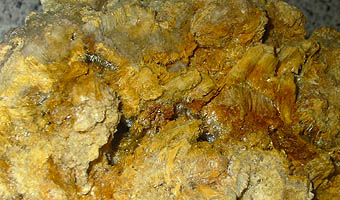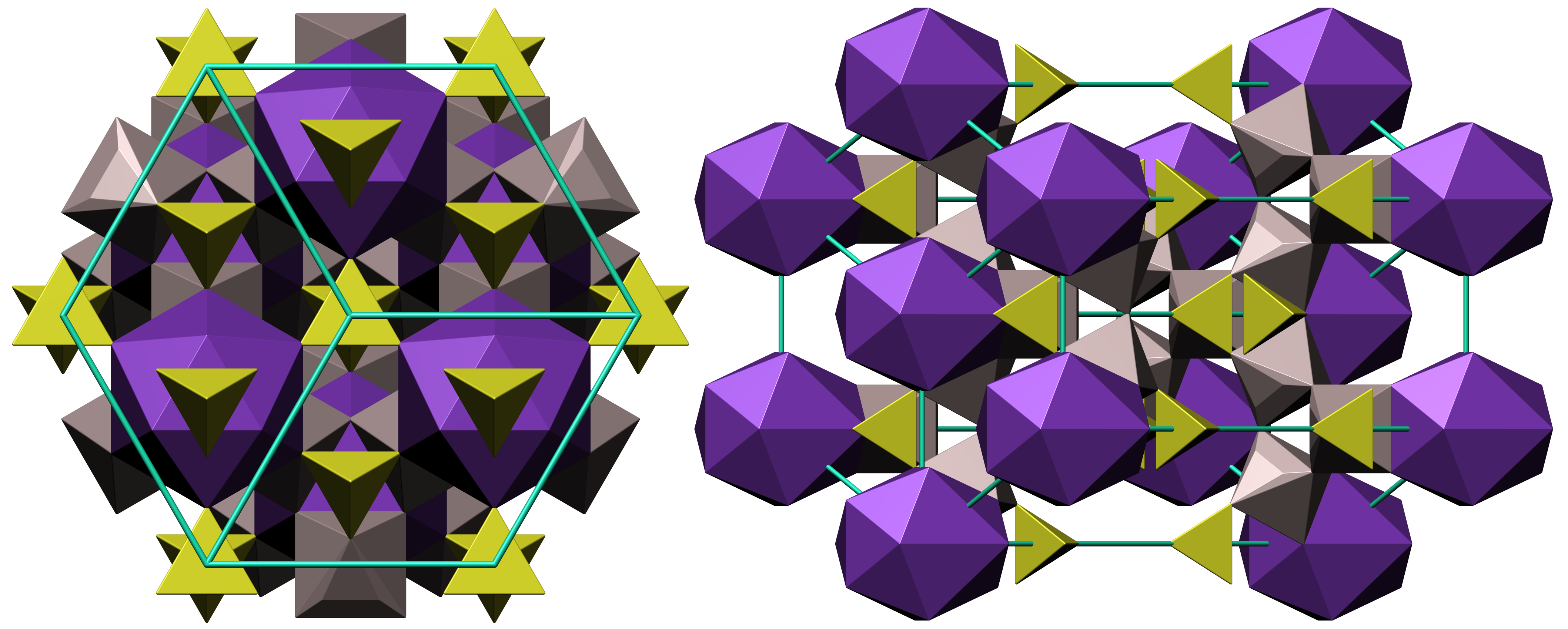Alunite on:
[Wikipedia]
[Google]
[Amazon]
Alunite is a hydroxylated  Alunite crystals morphologically are rhombohedron, rhombohedra with interfacial angles of 90° 50', causing them to resemble cubes. Crystal symmetry is
Alunite crystals morphologically are rhombohedron, rhombohedra with interfacial angles of 90° 50', causing them to resemble cubes. Crystal symmetry is  Sodium can substitute for potassium in the mineral, and when the sodium content is high, is called natroalunite.
Sodium can substitute for potassium in the mineral, and when the sodium content is high, is called natroalunite.
 Alunite is an analog of
Alunite is an analog of
Mineral Galleries
{{Authority control Aluminium minerals Potassium minerals Sulfate minerals Alunite group Trigonal minerals Minerals in space group 166 Luminescent minerals Industrial minerals
aluminium
Aluminium (or aluminum in North American English) is a chemical element; it has chemical symbol, symbol Al and atomic number 13. It has a density lower than that of other common metals, about one-third that of steel. Aluminium has ...
potassium
Potassium is a chemical element; it has Symbol (chemistry), symbol K (from Neo-Latin ) and atomic number19. It is a silvery white metal that is soft enough to easily cut with a knife. Potassium metal reacts rapidly with atmospheric oxygen to ...
sulfate mineral
The sulfate minerals are a class of minerals that include the sulfate ion () within their structure. The sulfate minerals occur commonly in primary evaporite depositional environments, as gangue minerals in hydrothermal Vein (geology), veins and as ...
, formula K Al3( S O4)2(O H)6. It was first observed in the 15th century at Tolfa Tolfa is a town and ''comune'' of the Metropolitan City of Rome, in the Lazio region of central Italy; it lies to the ENE of Civitavecchia by road.
It is the main center in the Monti della Tolfa, an extinct volcanic group between Civitavecchia a ...
, near Rome, where it was mined for the manufacture of alum
An alum () is a type of chemical compound, usually a hydrated double salt, double sulfate salt (chemistry), salt of aluminium with the general chemical formula, formula , such that is a valence (chemistry), monovalent cation such as potassium ...
. First called ''aluminilite'' by J.C. Delamétherie in 1797, this name was contracted by François Beudant three decades later to alunite.
 Alunite crystals morphologically are rhombohedron, rhombohedra with interfacial angles of 90° 50', causing them to resemble cubes. Crystal symmetry is
Alunite crystals morphologically are rhombohedron, rhombohedra with interfacial angles of 90° 50', causing them to resemble cubes. Crystal symmetry is trigonal
In crystallography, the hexagonal crystal family is one of the six crystal family, crystal families, which includes two crystal systems (hexagonal and trigonal) and two lattice systems (hexagonal and rhombohedral). While commonly confused, the tr ...
. Minute glistening crystals have also been found loose in cavities in altered rhyolite
Rhyolite ( ) is the most silica-rich of volcanic rocks. It is generally glassy or fine-grained (aphanitic) in texture (geology), texture, but may be porphyritic, containing larger mineral crystals (phenocrysts) in an otherwise fine-grained matri ...
. Alunite varies in color from white to yellow gray. The hardness
In materials science, hardness (antonym: softness) is a measure of the resistance to plastic deformation, such as an indentation (over an area) or a scratch (linear), induced mechanically either by Pressing (metalworking), pressing or abrasion ...
on the Mohs scale
The Mohs scale ( ) of mineral hardness is a qualitative ordinal scale, from 1 to 10, characterizing scratch resistance of minerals through the ability of harder material to scratch softer material.
The scale was introduced in 1812 by the Ger ...
is 4 and the specific gravity
Relative density, also called specific gravity, is a dimensionless quantity defined as the ratio of the density (mass of a unit volume) of a substance to the density of a given reference material. Specific gravity for solids and liquids is nea ...
is between 2.6 and 2.8. It is insoluble in water or weak acids, but soluble in sulfuric acid
Sulfuric acid (American spelling and the preferred IUPAC name) or sulphuric acid (English in the Commonwealth of Nations, Commonwealth spelling), known in antiquity as oil of vitriol, is a mineral acid composed of the elements sulfur, oxygen, ...
.
 Sodium can substitute for potassium in the mineral, and when the sodium content is high, is called natroalunite.
Sodium can substitute for potassium in the mineral, and when the sodium content is high, is called natroalunite.
 Alunite is an analog of
Alunite is an analog of jarosite
Jarosite is a basic hydrous sulfate of potassium and ferric iron (Fe-III) with a chemical formula of KFe3(SO4)2(OH)6. This sulfate mineral is formed in ore deposits by the oxidation of iron sulfides. Jarosite is often produced as a byproduct dur ...
, where aluminium replaces Fe3+. Alunite occurs as a secondary mineral on iron sulfate ores.
Alunite occurs as veins and replacement masses in trachyte
Trachyte () is an extrusive igneous rock composed mostly of alkali feldspar. It is usually light-colored and aphanite, aphanitic (fine-grained), with minor amounts of mafic minerals, and is formed by the rapid cooling of lava (or shallow intrus ...
, rhyolite
Rhyolite ( ) is the most silica-rich of volcanic rocks. It is generally glassy or fine-grained (aphanitic) in texture (geology), texture, but may be porphyritic, containing larger mineral crystals (phenocrysts) in an otherwise fine-grained matri ...
, and similar potassium rich volcanic rocks. It is formed by the action of sulfuric acid
Sulfuric acid (American spelling and the preferred IUPAC name) or sulphuric acid (English in the Commonwealth of Nations, Commonwealth spelling), known in antiquity as oil of vitriol, is a mineral acid composed of the elements sulfur, oxygen, ...
bearing solutions on these rocks during the oxidation
Redox ( , , reduction–oxidation or oxidation–reduction) is a type of chemical reaction in which the oxidation states of the reactants change. Oxidation is the loss of electrons or an increase in the oxidation state, while reduction is ...
and leaching of metal sulfide deposits. Alunite also is found near volcanic fumarole
A fumarole (or fumerole) is a vent in the surface of the Earth or another rocky planet from which hot volcanic gases and vapors are emitted, without any accompanying liquids or solids. Fumaroles are characteristic of the late stages of volcani ...
s. The white, finely granular masses closely resemble finely granular limestone
Limestone is a type of carbonate rock, carbonate sedimentary rock which is the main source of the material Lime (material), lime. It is composed mostly of the minerals calcite and aragonite, which are different Polymorphism (materials science) ...
, dolomite, anhydrite
Anhydrite, or anhydrous calcium sulfate, is a mineral with the chemical formula CaSO4. It is in the orthorhombic crystal system, with three directions of perfect cleavage parallel to the three planes of symmetry. It is not isomorphous with the ...
, and magnesite
Magnesite is a mineral with the chemical formula ( magnesium carbonate). Iron, manganese, cobalt, and nickel may occur as admixtures, but only in small amounts.
Occurrence
Magnesite occurs as veins in and an alteration product of ultramafic r ...
in appearance. The more compact kinds from Hungary are so hard and tough that they have been used for millstones.
Historically extensive deposits were mined in Tuscany
Tuscany ( ; ) is a Regions of Italy, region in central Italy with an area of about and a population of 3,660,834 inhabitants as of 2025. The capital city is Florence.
Tuscany is known for its landscapes, history, artistic legacy, and its in ...
and Hungary
Hungary is a landlocked country in Central Europe. Spanning much of the Pannonian Basin, Carpathian Basin, it is bordered by Slovakia to the north, Ukraine to the northeast, Romania to the east and southeast, Serbia to the south, Croatia and ...
, and at Bulahdelah, New South Wales, Australia
Australia, officially the Commonwealth of Australia, is a country comprising mainland Australia, the mainland of the Australia (continent), Australian continent, the island of Tasmania and list of islands of Australia, numerous smaller isl ...
. It is currently mined at Tolfa, Italy
Italy, officially the Italian Republic, is a country in Southern Europe, Southern and Western Europe, Western Europe. It consists of Italian Peninsula, a peninsula that extends into the Mediterranean Sea, with the Alps on its northern land b ...
. In the United States it is found in the San Juan district of Colorado
Colorado is a U.S. state, state in the Western United States. It is one of the Mountain states, sharing the Four Corners region with Arizona, New Mexico, and Utah. It is also bordered by Wyoming to the north, Nebraska to the northeast, Kansas ...
; Goldfield, Nevada
Goldfield is an unincorporated town and census-designated place and the county seat of Esmeralda County, Nevada.
It is the locus of the Goldfield CDP which had a resident population of 268 at the 2010 census, down from 440 in 2000. Gold ...
; the ghost town
A ghost town, deserted city, extinct town, or abandoned city is an abandoned settlement, usually one that contains substantial visible remaining buildings and infrastructure such as roads. A town often becomes a ghost town because the economi ...
of Alunite, Utah near Marysvale; and Red Mountain near Patagonia, Arizona. The Arizona occurrence lies appropriately above a canyon named ''Alum Gulch''. Alunite is mined as an ore of both potassium and aluminium at Marysvale. Some of the ore
Ore is natural rock or sediment that contains one or more valuable minerals, typically including metals, concentrated above background levels, and that is economically viable to mine and process. The grade of ore refers to the concentration ...
deposits were located by airborne and satellite multispectral imaging.
An article in the May/June 2019 issue of Archaeology magazine states that in China, in Henan province, an assortment of ceramic objects and jars were found, dating back 2000 years. In one of the jars, a mixture of alunite and potassium nitrate
Potassium nitrate is a chemical compound with a sharp, salty, bitter taste and the chemical formula . It is a potassium salt of nitric acid. This salt consists of potassium cations and nitrate anions , and is therefore an alkali metal nit ...
was found. The mixture was then thought to be a "mixture of immortality" mentioned in ancient Chinese texts. Obviously, this does not appear to have succeeded.
See also
*Acid mine drainage
Acid mine drainage, acid and metalliferous drainage (AMD), or acid rock drainage (ARD) is the outflow of acidic water from metal mines and coal mines.
Acid rock drainage occurs naturally within some environments as part of the rock weatherin ...
* Alum
An alum () is a type of chemical compound, usually a hydrated double salt, double sulfate salt (chemistry), salt of aluminium with the general chemical formula, formula , such that is a valence (chemistry), monovalent cation such as potassium ...
* Jarosite
Jarosite is a basic hydrous sulfate of potassium and ferric iron (Fe-III) with a chemical formula of KFe3(SO4)2(OH)6. This sulfate mineral is formed in ore deposits by the oxidation of iron sulfides. Jarosite is often produced as a byproduct dur ...
References
*External links
Mineral Galleries
{{Authority control Aluminium minerals Potassium minerals Sulfate minerals Alunite group Trigonal minerals Minerals in space group 166 Luminescent minerals Industrial minerals